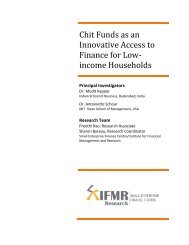Government of India Volume I: Analysis and Recommendations
Government of India Volume I: Analysis and Recommendations
Government of India Volume I: Analysis and Recommendations
Create successful ePaper yourself
Turn your PDF publications into a flip-book with our unique Google optimized e-Paper software.
MICRO-PRUDENTIAL REGULATION<br />
Table <strong>of</strong> <strong>Recommendations</strong> 6.5 Regulation <strong>of</strong> risk-taking<br />
The regulator will have the following powers in connection with reducing risks:<br />
1. Regulating investments <strong>of</strong> own funds <strong>and</strong> consumers’ funds;<br />
2. Regulating claims on consumers’ funds;<br />
3. Regulating to foster business processes that reduce risks;<br />
4. Regulating the valuation st<strong>and</strong>ards for assets <strong>and</strong> liabilities <strong>of</strong> regulated persons;<br />
5. Regulating transactions with related persons; <strong>and</strong><br />
6. Regulating liquidity management.<br />
Table <strong>of</strong> <strong>Recommendations</strong> 6.6 Regulation <strong>of</strong> loss absorption<br />
The regulator will have the following powers in connection with absorbing losses:<br />
1. Defining categories <strong>of</strong> capital resources, based loss absorbing capacities;<br />
2. Prescribing the amount <strong>of</strong> different types <strong>of</strong> capital resources required to be held, <strong>and</strong> the solvency requirements;<br />
3. Defining criteria for assessing compliance with capital resource requirements;<br />
4. Defining how regulated persons should manage the capital resources, including the requirement to notify<br />
the regulator while issuing certain capital instruments;<br />
5. Regulating how the changes in values <strong>of</strong> assets <strong>and</strong> liabilities will be recognised; <strong>and</strong><br />
6. M<strong>and</strong>ating purchase <strong>of</strong> insurance from Resolution Corporation.<br />
regulated persons. The draft Code also empowers the regulator to impose liquidity requirements<br />
on the regulated persons.<br />
6.4.3. Regulation <strong>of</strong> loss absorption<br />
These powers allow the regulator to require the regulated persons to keep capital resources<br />
<strong>and</strong>/or purchase insurance from resolution corporation for absorbing losses. Capital<br />
resources act as buffers that are typically used for covering unexpected losses arising<br />
from under-performing investments or under-valuation <strong>of</strong> liabilities.<br />
In conventional thinking, equity capital is thought to play this role. Loss absorption<br />
functions can be provided by a variety <strong>of</strong> instruments not limited to equity capital. Different<br />
instruments have different loss absorption capacities, <strong>and</strong> these capacities may also<br />
vary with time. Contingent capital has debt-like features, but can become equity-like loss<br />
absorber depending on certain conditions. If there are instruments that require deep <strong>and</strong><br />
liquid markets, during times <strong>of</strong> crisis, this loss absorption capacity may be constrained.<br />
The regulator will need to think about loss absorption capacities across different times,<br />
<strong>and</strong> ensure that there are adequate buffers in place for normal times as well as for times<br />
<strong>of</strong> crisis (see Table 6.6).<br />
A mechanism <strong>of</strong> loss absorption being built in this framework recommended by the<br />
Commission is the resolution mechanism, which presently does not exist in <strong>India</strong>. For<br />
certain financial service providers, the regulator should m<strong>and</strong>ate purchase <strong>of</strong> insurance<br />
from resolution corporation, as a pre-condition for undertaking the activities they propose<br />
to undertake. For example, for banking service providers, the regulator may impose<br />
a condition <strong>of</strong> getting their deposits insured upto a limit determined by the resolution<br />
corporation.<br />
6.4.4. Regulation <strong>of</strong> governance, management <strong>and</strong> internal controls<br />
These instruments empower the regulator to prescribe st<strong>and</strong>ards for good governance.<br />
Since the regulator shares the responsibility for achieving micro-prudential objectives<br />
with the board <strong>and</strong> management <strong>of</strong> the regulated person, it is important that these persons<br />
are prudently governed <strong>and</strong> managed (see Table 6.7).<br />
FINANCIAL SECTOR LEGISLATIVE REFORMS COMMISSION 61



